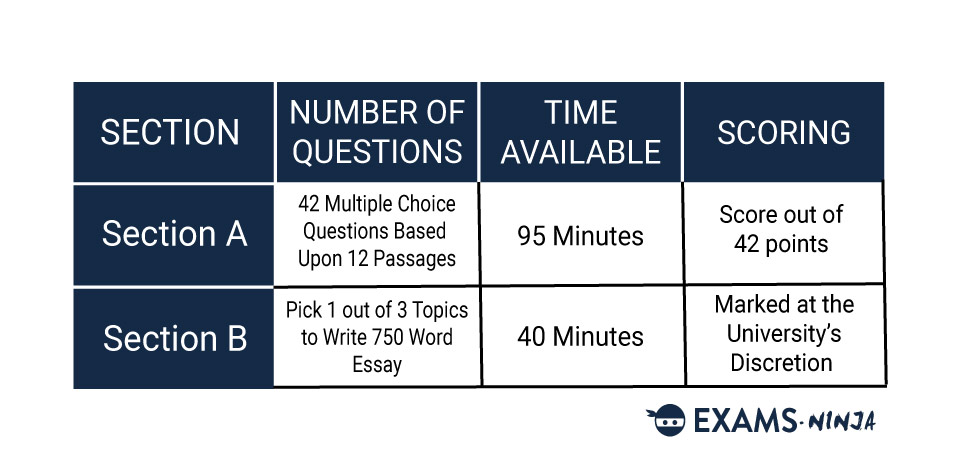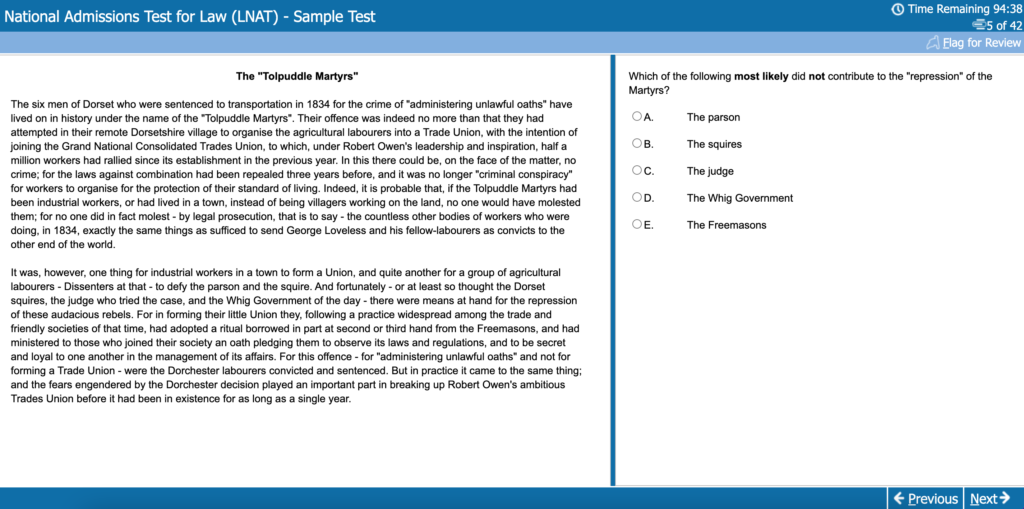LNAT Guides
LNAT Section A - Your Guide to the First Section of the LNAT
Written by: Matt Amalfitano-Stroud
If you’re looking to study Law at the UK’s top universities, the chances are you’ll be taking the LNAT as part of your application. The LNAT will test you on your comprehension, deduction and interpretation, so reading and writing skills are essential. Section A of the test focuses on your reading abilities, and we’ll be looking at everything you need to know for it here. Start your practice by reading this guide!
1/5
BASICS OF THE LNAT
Before we go into detail on Section A, let’s look at a brief overview of what the LNAT is and why you need to take it.

What is the LNAT?
The Law National Admissions Test (LNAT) is a two-paper exam used to test an applicant’s skills in various disciplines of reading and writing.
As the name suggests, the test is used primarily as an admissions test for applicants of Law at a university level, starting from undergraduate. The test is taken by applicants for a total of 9 universities in the UK and 2 international universities. These universities include Oxford, Cambridge, University College London and the London School of Economics, some of the highest-rated Law universities in the UK.
You will be given a total of 2 hours and 15 minutes to complete the test. This time will be split between two sections, Section A and Section B.
Section A
Section A will see you answering 42 multiple-choice questions based on a total of 12 argumentative passages covering a variety of topics. Each passage will have three or four questions to answer and you will have 95 minutes to answer them all.
These will not be specifically focused on law but will instead cover topics including politics, science, history, technology and much, much more! Don’t worry though, these questions will not test you on your knowledge of these subjects, but rather your ability to decipher meanings from the text itself, whether it be the writer’s intentions or the purposes of words and sentences.
Section B
In Section B, you will need to choose one of three questions to write an argumentative essay on. You will have 40 minutes to complete this and you will be limited to 750 words maximum.
Like Section A, the questions asked will cover a variety of general topics that are usually relevant to current issues. Examples could include, “In what circumstances should abortion be permitted and why?” or “The Olympic games, today, are less a test of personal athleticism and more a measure of national investment and authority. Do you agree?”. A certain level of understanding of a chosen topic will be needed to effectively answer these questions, but this Section is more so a test of your comprehension and reasoning abilities.
The LNAT can be sat at any time between September 1st and January 20th (October 15th for Oxbridge applicants) and must be taken at an LNAT testing centre. You’ll need to register on the LNAT website to sit the exam, which can be done from August 1st until September 15th for Oxford applicants and January 15th for everyone else. Also, note that there is a fee of £75 for testing in the UK and £120 outside of the UK.
How is LNAT Section A Scored?
The LNAT scoring for Section A is fairly simple, giving you a mark out of 42 based on how many questions you got correct. Section B however is marked differently for each university.
Some unis, such as Oxford, go extremely in-depth in their essay marking and place great emphasis on it when choosing candidates. Others however do not consider Section B at all except in specific situations, including Glasgow and Kings College London and London School of Economics. If you’d like to find out more about how the LNAT is scored and what marks you should be aiming for, check out our complete guide to LNAT Scoring and Results.
To recap, here’s what we’ve learnt about the LNAT so far:
LNAT Exam Format
If you’d like to go into more depth about the LNAT as a whole, we have a Definitive LNAT guide to answer all your LNAT questions!
Preparing for the LNAT can be tough, let Exams.Ninja help you through it!
With the LNAT Preparation Platform, you’ll gain access to a comprehensive collection of revision notes, strategy guides and expert tutorials to teach you everything you need to know about picking apart a passage and writing a flawless argument!
2/5
WHAT TO EXPECT FROM THE LNAT SECTION A
Now we know more about the LNAT, let’s take a deeper dive into Section A of the test and see what we can expect from it.
As we’ve already seen, Section A of the LNAT is a series of multiple-choice questions, 42 in total, that are spread out between 12 short-medium length passages based on a variety of general topics. Typically , you’ll be getting 3-4 questions per passage.
This image is taken from an online sample test. It should give you a rough idea of what you can expect the LNAT to look like on the day:
With 95 minutes to complete this section, it seems at first that you’ll have quite a generous time limit to complete all of these questions compared to other exams. However, there are several factors to take into consideration before entering the test that will help you utilise your time in the best way.
Each of the 12 passages you’ll be given is usually 3-6 paragraphs long. Before answering any questions you’ll, of course, be reading the relevant passage but you will most likely need to go over it multiple times in order to fully understand the writing. Questions will usually reference a specific portion of the passage, so you’ll be able to read through as many times as you need to be able to find the correct answer.
On top of this, you’ll need to save some time at the end to double-check all of your answers. It’s incredibly easy to make dumb mistakes when taking an exam, but taking some time when you’re not under timed pressure to double-check every answer you’ve given will greatly increase your chances of picking up and correcting any errors.
Once you’ve factored all of this into your timings, 95 minutes will actually feel less generous than you initially thought. You most likely won’t be spending time staring into space, but if you do have spare time, use it wisely!
We’ve already spoken about the scoring of the LNAT, but let’s take a look at the kind of results you should be aiming for.
As we know, your result in Section A will depend on the number of questions you answer correctly, with the total out of 42 being your final score. Below are the average scores for various universities in the 2020-21 admissions cycle:
LNAT University Average Results

26

26

27

22

26

20
For the top law schools, you’ll be wanting to aim for the high 20’s at least, while other unis may be a bit more forgiving. Bear in mind that the results for Section B will have a different impact depending on the uni you apply for. For some, the score for Section A will be the only one that is considered in the application. You can find out more about this in our LNAT Scoring Guide.
3/5
WHAT DO I NEED TO KNOW FOR SECTION A?
The skills that you’ll need to succeed in the LNAT are pretty broad and can be used in a large variety of scenarios. Unlike many other exams, you won’t be solving problems but instead attempting to interpret passages using a variety of disciplines. Let’s run down the type of things you’ll need to look out for when reading through each question.
The Two Types of LNAT Questions
Within Section A of the LNAT, there are two types of questions; Argument & Analysis and Literary Style Questions.
Argument and Analysis Questions
These types of questions will centre around the argument or point that is being expressed within a passage. You’ll typically be asked to identify elements of the author’s passage that relate to their argument, or you may be looking for the overall underlying argument throughout.
The key to these questions is to understand what the author was trying to say in order to explain their views.
Literary Style Questions
These types of questions will ask you to determine the meaning behind certain words and phrasing used by the author. These questions won’t necessarily relate to the author’s argument, but rather the individual elements of what they have written.
You will need to ensure you pay close attention to how the author writes to answer these questions.
Literary Elements to Look Out For
Arguments vs Assertions vs Explanations
These are the three pillars of a typical passage that you will find in the LNAT. The differences are pretty clear once you understand them, so you’re job when reading will be to recognise when each is being used and for what purpose.
An argument is the only of these that are intended to persuade. The basic format is a conclusion that follows a premise.
Assertions are simply a statement of facts. While they may be argued against, an assertion on its own is simply a blunt statement with no provision of evidence towards its validity.
Explanations take the idea of an assertion, a truthful statement, and provide the reasoning behind what makes this statement so. While this still isn’t an attempt to persuade a reader, it could still be considered the strongest of the three pillars due to its provision of factual evidence.
Deductive vs Inductive Arguments
All of the text that you’ll be given will be argumentative in some way, so understanding the difference between these two types of argument is incredibly important.
A deductive argument is essentially an argument that uses inarguable facts to present a truthful conclusion to said argument. The statements used to make up the argument should have strong evidence to back them up, or else the strength of the argument will fall apart.
An inductive argument is an argument that draws a conclusion based on specific observations. This type of argument lacks the indisputable evidence of a deductive argument and relies more heavily on assumptions and hypotheticals. Therefore, the strength of the argument relies on the validity of the observations presented.
We have a full guide on assumptions available to give you more insight into what you’ll be seeing in the Section A passages and questions.
Premise vs Conclusion
A premise and conclusion are both essential components to any argument being presented. A premise is a statement that can be argued for using another statement or a conclusion.
A conclusion is a summary of everything that has been presented for an argument. These are typically stated explicitly in order to create clarity of an argument to the reader.
Fact vs Opinion
Facts and opinions are often easy to confuse due to the number of forms each one can take. You’ll almost certainly be required to point out a fact or opinion in at least one of your Section 1 questions.
The basic difference between a fact and an opinion is that a fact can be tested or provide evidence to be definitively labelled true or false, whereas an opinion cannot.
Correlation vs Causation
You’ll most likely have heard that “correlation does not imply causation”. A correlation is a comparison between two or more specific events that occur within similar timeframes or parameters, either positively or negatively.
Causation however is a factually indisputable connection between different separate events which can be backed up with reliable evidence. This differs from a correlation, which is only a relationship between two events that is not proven to be caused by either one.
These are all elements of writing that you will need to understand to a good degree, as all the questions in Section A will relate to at least one of these points.
4/5
HOW CAN I PREPARE FOR SECTION A?
Now you know what skills you’ll need, it’s time to learn how you can best prepare for the big day.
1. Develop a Preparation Plan
While you’re not going to be revising specific subjects and facts, you’ll still need to devote plenty of time to prepare for the LNAT. Going into it blind can be incredibly overwhelming, so creating a plan for how to tackle it will help you get organised and find the motivation to study.
You should dedicate specific amounts of time to the areas that you feel you need the most practice with. While covering everything you need to know is advisable, you’ll most likely have areas that you are more confident with, so it’s best to prioritise things that you’re not as sure about. Our next two points will guide you on what exactly you should be doing with your time.
Remember, the LNAT is only one part of the application process, so you will need to spread your time across other aspects as well. This will include your interview and personal statement, as well as revising for your A-Levels or equivalent!
Need some inspiration for your preparation plan? Check out our 6-Month Preparation Timeline for some ideas on how you should use your time!
2. Read. A lot!
The most valuable form of revision you can do for the LNAT is reading. It’s arguably the main thing that the LNAT will test you on, so you need to be able to read the passages you’re given thoroughly and be able to understand what the writer is saying with their words and sentence structure.
Non-fiction literature is definitely the best type of reading for the LNAT, as all of the passages in the exam will be non-fiction. Try to read a variety of texts, including factual pieces, argumentative articles and historical research, although there are plenty more types of work to find.
You should make a daily habit of reading the news, whether online or in a physical paper. Any form of regular publication will house a great variety of factual and opinion pieces that will provide you with plenty to analyse. You could even try writing your own LNAT style questions based on an article you’ve read, which you could go back to at a later date to try and answer.
3. Practice Makes Perfect
It’s cliché, but it’s true! There are plenty of resources available to practice your LNAT skills, with practice questions and papers being the most effective. Answering practice questions will allow you to reaffirm your knowledge or catch out errors in your thought process, which is especially useful when a worked solution is provided.
To give yourself a taste of the real exam, you should complete a practice paper under the official time limits. Doing this will allow you to practice your time management during the stress of an exam.
When choosing LNAT support, Exams.Ninja is the correct answer!
Our LNAT Preparation Platform is the most effective way to prepare for real exam, thanks to our collection of expert tutorials, practice questions and mock papers. Sign up today to try the platform for free.
5/5
EXAMPLE PRACTICE QUESTIONS
To help you get an idea of what questions you’ll be answering in Section A, we’ve prepared a pair of LNAT passages along with their questions for you to try out!
LNAT Practice Passage 1
Passage 61 – Laughter: An Essay on the Meaning of Comic
By Henri Bergson, member of the Institute Professor at the College de France
What does laughter mean? What is the basal element in the laughable? What common ground can we find between the grimace of a merry-andrew, a play upon words, an equivocal situation in a burlesque, and a scene of high comedy? The greatest of thinkers, from Aristotle downwards, have tackled this little problem that has a knack of baffling every effort, of slipping away and escaping only to bob up again, a pert challenge flung at philosophic speculation. Our excuse for attacking the problem in our turn must lie in the fact that we shall not aim at imprisoning the comic spirit within a definition. We regard it, above all, as a living thing. We shall confine ourselves to watching it grow and expand. Passing by imperceptible gradations from one form to another, it will be seen to achieve the strangest metamorphoses. We shall disdain nothing we have seen. And maybe we may also find that we have made an acquaintance that is useful. For the comic spirit has a logic of its own, even in its wildest eccentricities. It has a method in its madness. It dreams, I admit, but it conjures up in its dreams, visions that are at once accepted and understood by the whole of a social group. Can it then fail to throw light for us on the way that human imagination works, and more particularly social, collective and popular imagination? Begotten of real life and akin to art, should it not also have something of its own to tell us about art and life?
At the outset, we shall put forward three observations which we look upon as fundamental. The first point to which attention should be called is that the comic does not exist outside the pale of what is strictly human. A landscape may be beautiful, charming and sublime, or insignificant and ugly; it will never be laughable.
Here I would point out, as a symptom equally worthy of notice, the absence of feeling which usually accompanies laughter. Indifference is its natural environment, for laughter has no greater foe than emotion. I do not mean that we could not laugh at a person who inspires us with pity, for instance, or even with affection, but in such a case we must, for the moment, put our affection out of court and impose silence upon our pity. It is enough for us to stop our ears to the sound of music, in a room where dancing is going on, for the dancers at once to appear ridiculous. How many human actions would stand a similar test? Should we not see many of them suddenly pass from grave to amusing, on isolating them from the accompanying music of sentiment? To produce the whole of its effect, then, the comic demands something like a momentary anaesthesia of the heart. Its appeal is to intelligence, pure and simple.
This intelligence, however, must always remain in touch with other intelligences. And here is the third fact to which attention should be drawn. Our laughter is always the laughter of a group. Perhaps it has happened to you, when seated in a railway carriage or at table d’hôte, to hear travellers relating to one another stories which must have been comic to them, as they laughed heartily. Had you been in their company, you would have laughed like them. But as you were not, you had no desire whatever to do so.
To understand laughter, we must put it back into its natural social environment and above all must we determine the utility of its function, which is a social one. Laughter must answer to certain requirements of life in common. It must have a social signification.
LNAT Practice Questions 1
1. The writer uses the word ‘basal’ to mean:
A) Essential
B) Notable
C) Undeveloped
D) Elusive
E) Significant
The correct answer is A.
The question which follows the line in which ‘basal’ is used (‘what common ground…’) sheds light on the sense in which it is being used by the author. If a feature is common to many different situations in which laughter occurs, it suggests that the feature is the ‘essential’ element in the laughable.
2. What is the central motivation for the writer’s exploration of the topic of laughter?
A) To avoid imprisoning the concept within a definition
B) To watch it achieve ‘strange metamorphoses’
C) To throw light on human functioning and behaviour
D) To demonstrate that laughter has ‘a method in its madness’
E) The fact that other great thinkers have failed to reach a conclusion
The correct answer is C.
In the second paragraph, the author suggests that his exploration of the topic of laughter cannot fail to throw light on the way the human imagination works and that it must have something to tell us about life. Although A, B, D and E are mentioned in the passage, nothing in the author’s language suggests that these are the goals of the author’s investigation – and they seem to relate to the method of the investigation (A), background information about the topic (E) and mere observations on the topic (D and B).
3. Which one of the following is not used to characterise laughter?
A) It is the laughter of a group
B) Social
C) Sentimental
D) Illuminating
E) A living thing
The correct answer is C.
The second paragraph states that laughter demands an anaesthesia of the heart, suggesting that the absence of sentiment is a precondition for laughter. A can be found in the penultimate paragraph, B is derived from the statement in the final paragraph that laughter has a social function, D is derived from the statement in the first paragraph that laughter can throw light on human life/imagination and E is also stated in the first paragraph (‘we regard it as a living thing’). Therefore, C is the only answer not used to characterise laughter.
LNAT Practice Passage 2
Passage 58 – Jobs for graduates
Joining a tech start-up is the number one trendy move for top graduates across the UK and the US today. Graduates nowadays are gravitating towards app development and other technology markets. Indeed, these industries are welcoming graduates with open arms; opportunities in search engine optimisation and in pay-per-click advertising. However, many graduates do not properly think through the options and choose these roles all too quickly. It is depressing to see young people just go and do something because it seems ‘cool’ rather than because it is actually of any use. They swan around thinking they are so on trend and yet most of them produce nothing of value whatsoever. Further, a lot of their jobs are pretty dull in practice.
More interesting, in my view, is a career in the arts – for instance, a career as an art gallery curator. This job involves the managing of collections of paintings and objects. Curators also undertake art research, identifying and cataloguing paintings and other items. Moreover, they interact with the public, answering visitors’ queries and giving talks about the art collections they manage. The job also involves organising displays and negotiation funding for the sale or loan of paintings to the art gallery. An alternative job in the arts is that of a museum curator. These curators manage collections of objects of historical or scientific interest. They ensure that these objects are stored in the right conditions, give talks to groups and liaise with staff in other museums. Such curators have to have good finance management skills as they are given the responsibility of managing museum budgets. One unfortunate consequence of the recession has been the cutting of government provision to the arts. Regardless, it is an exciting career path for those who have the strength of character to overcome the difficulties the area is currently facing. The opportunity to create and to help others to do the same has to be one the most exciting things anyone could do in their twenties.
Jobs in finance may seem like good ideas for graduates but jobs in publishing actually offer more opportunities for the truly talented. This is because publishers are much more rigorous in their hiring procedures – and rightly so – and as such, get a much better crop of graduates. One type of job in publishing is that of the commissioning editor. These individuals commission or buy new authors, book titles, or ideas for publication. You will choose books or media products that you think will sell well. You will also monitor the performance of published titles. If you love reading and you are able to combine that with market research and spot market trends, then this could be the role for you. Content creation is another option for those who enjoy writing; firms are crying out for graduates to produce content which will enable them to promote their businesses. Graduates hoping to produce or edit content will do well in this fast-growing industry. The point here is that although I am sure you have been told that jobs in the industries that graduates typically go into have a lot to offer, you should not close your mind to other options. Think a little bigger!
LNAT Practice Questions 2
1. What is the attitude of the author towards those who join start-ups?
A) The author looks down on them
B) The author admires them
C) The author thinks they are selfish
D) The author does not understand their motivations
E) The author is accepting of them
The correct answer is A.
We know this because the author uses phrases such as ‘swan around thinking they are so on trend and yet most of them produce nothing of value whatsoever’, indicating an attitude of derision towards them.
2. Which pair of jobs does the author draw a direct contrast between?
A) Jobs in technology and jobs in government
B) Jobs in finance and jobs in the arts
C) Jobs in the arts and jobs in publishing
D) Jobs in publishing and jobs in technology
E) Jobs in finance and jobs in publishing
The correct answer is E.
The sentence ‘Jobs in finance may seem like good ideas for graduates but jobs in publishing actually offer more opportunities for the truly talented’ is a direct comparison.
3. What is the aim of the article?
A) To recruit people into publishing
B) To recruit people into the arts
C) To get students to work hard at university
D) To get students to consider less traditional career paths
E) To argue that careers in arts are the best
The correct answer is D.
This is only revealed in the final paragraph when the author says, ‘The point here is that although I am sure you have been told that jobs in the industries that graduates typically go into have a lot to offer, you should not close your mind to other options. Think a little bigger!’
If you want even more LNAT practice questions, you can find more than 300 of them on the Exams.Ninja Preparation Platform, each with a fully worked solution to make everything perfectly clear!
You should now be ready to become a master of deduction and reasoning! There’s a lot to remember when preparing for the LNAT but once you’ve got a firm understanding of what you should be looking out for in a passage, you should be able to get a great score in the exam! Section A is only half of it though, so if you want to learn more about Section B, check out our LNAT Section B Guide.
The LNAT is one of the biggest obstacles on your journey to study law, Exams.Ninja can help you smash it!
The Exams.Ninja LNAT Preparation Platform is the perfect way to combine all of your revision into one convenient place. When you sign up, you’ll be able to access:
Training Temple – check out amazing tips, revision notes and expert tutorials to gain an understanding of everything you’ll need to know.
Practice Dojo – Put your knowledge to the test with over 1,350 practice questions spanning both sections of the LNAT. Each answer is fully explained to assure you understand what it all means.
Exams Arena – The ultimate challenge, you’ll be able to take a realistic mock exam with official past papers. You’ll get an estimated mark to track your progress for the real thing!
Sign up today to try the LNAT Preparation Platform for free!



